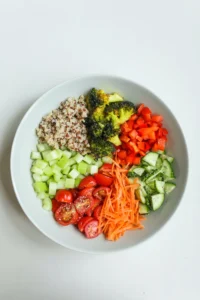Generated by Contentify AI
- Introduction
- The Importance of Healthy Eating for Children
- Fostering Positive Relationships with Food
- Building a Balanced Plate
- Snack Ideas for Kids
- Getting Kids Involved in Meal Planning and Preparation
- Addressing Picky Eating Habits
- Teaching Children about Mindful Eating
- Creating a Healthy Eating Environment
- Conclusion

Introduction
Healthy eating habits are essential for children as they grow and develop. Eating healthy food helps children stay strong and active and provides them with the energy they need to get through the day. Establishing healthy eating habits in childhood can also help to prevent health problems in adulthood.
In today’s world, it can be difficult for children to make healthy food choices. With so much fast food and processed snacks available, it can be hard for children to make the right choices. However, with proper guidance and support, children can learn to make healthy food choices that will benefit them long-term.
When developing healthy eating habits for children, it is important to make sure they are getting a balanced diet that includes plenty of fruits and vegetables, whole grains, low-fat dairy, and lean proteins. It is also important to limit sugary drinks, processed snacks, and fast food.
In addition to providing a balanced diet, it is also important to follow good eating habits that will help children form healthy eating habits. Encouraging children to eat slowly, to listen to their body’s hunger and fullness cues, and to eat when they are hungry and stop when they are full are all good habits to instill in children.
Involving kids in meal planning and cooking can also be a great way to teach them about healthy foods and encourage them to eat healthy. Making healthy meals and snacks fun and interesting can help to keep kids motivated to make healthy choices.
By teaching children the importance of healthy eating habits and providing them with guidance and support, parents can help to ensure their children grow up with healthy habits that will benefit them for life.
The Importance of Healthy Eating for Children
It is essential for children to learn healthy eating habits from an early age. Eating healthy foods not only helps to ensure proper nutrition, but it can also help children develop a positive relationship with food and a healthy relationship with their body.
It is important to teach children the basics of nutrition and how to make healthy food choices. Incorporating meals with lots of fruits and vegetables, whole grains, and lean proteins helps to provide essential vitamins, minerals, and energy that children need. It is also important to provide healthy snacks, such as fresh fruit, nuts, and yogurt, to ensure that children are not relying on unhealthy snacks to fill them up between meals.
It is also important to get children involved in the process of cooking and creating healthy meals. Involving them in food preparation and grocery shopping provides them with the knowledge to make healthy choices and understand the importance of healthy eating. Additionally, allowing them to help with meal planning and grocery shopping can also increase their interest in eating healthy foods.
A healthy diet doesn’t have to be boring. Eating healthy can be fun and exciting, especially when children get to choose and create their own meals. Exploring new foods and flavors can help to expand their palates while introducing them to the importance of nutrition.
Most importantly, it is important to model healthy eating habits. Children learn and take cues from adults, so making sure to lead by example is key. Eating healthy meals together as family, and sitting down together for meals without distractions, can provide children with positive role models and create a sense of connection.
Healthy eating habits are an important part of a child’s development. Teaching children the importance of nutrition from a young age will help to ensure that they grow up understanding the value of eating healthy foods and develop a positive relationship with food.
Fostering Positive Relationships with Food
With the rise of technology and the prevalence of digital media, it’s more important than ever to teach children about healthy eating habits. Good nutrition is vital to a child’s development, and it’s up to parents to create a positive relationship between children and food.
One of the best ways to ensure children develop healthy eating habits is to foster a positive relationship between them and their food. This means teaching children to appreciate food for its flavor, texture, and nutritional value. Developing a healthy relationship with food is a key factor in developing lifelong health habits.
One way to foster a positive relationship is to make meal times enjoyable. Take the time to sit down with your child, turn off the screens, and talk about the food. Explain why certain foods are healthy and encourage them to try new foods. Make mealtime a pleasant experience that children look forward to.
It’s also important to make sure children have a balanced diet. Make sure they are getting enough protein, fruits, veggies, and grains each day. Involve your child in meal preparation and grocery shopping. This can help them understand the different types of food, where food comes from, and the importance of making healthy choices.
Most importantly, don’t use food as a reward or punishment. Doing so can create an unhealthy relationship and make children feel guilty about food. If you want to reward good behavior, find a non-food related reward.
Fostering a positive relationship with food can be challenging at times, but with the right guidance, children can learn to appreciate and enjoy healthy foods. With a bit of patience and some creative ideas, you can help your children develop healthy eating habits and a lifelong relationship with food.
Building a Balanced Plate
Having a balanced plate for each meal is a key component of healthy eating habits for children. Eating a balanced plate helps ensure that our kids are getting enough of the essential nutrients they need to grow and develop. It also helps to avoid unhealthy eating habits, such as overeating or eating too much of one type of food.
A balanced plate should be made up of different food groups. This includes fruits, vegetables, grains, dairy, and proteins. Each group provides us with different types of energy and nutrients, so it’s important to have a variety of different items in each meal. For instance, fruits are packed with vitamins and minerals, while grains provide us with energy and protein helps to build strong bones and muscles.
To ensure that your plate is balanced, try using a 9-inch plate and divide it into four sections. Aim to fill half of the plate with fruits and vegetables, one quarter with proteins, and the last quarter with grains. This will give your child the right balance of energy and nutrients.
When it comes to adding protein, make sure to choose lean cuts of meat, fish, and poultry. For dairy, opt for low-fat or non-fat varieties like milk, yogurt, and cheese. For grains, opt for whole grain varieties such as brown rice, quinoa, or oats.
It’s also important to make sure that your child is drinking enough water throughout the day. Water helps to keep kids hydrated and may help them feel full. Aim to encourage your child to drink at least eight glasses of water a day.
Creating a balanced plate is an important part of healthy eating habits for children. By ensuring that your child’s plate is made up of different food groups, you can help them get the energy and nutrients they need to stay healthy and grow strong.
Snack Ideas for Kids
Snacking is an important part of a healthy lifestyle for kids. While it is important to ensure that children are eating nutritious meals throughout the day, snacking can be a great way to help maintain energy levels, bridge the gap between meals, and provide an opportunity to introduce new foods.
When it comes to snacks, it is important to look for options that are nutritious and delicious. Here are some ideas for healthy snacks that kids can enjoy:
1. Fresh Fruits and Vegetables: Fresh fruits and vegetables are always a great snack option. They are packed with vitamins, minerals, and fiber and are low in fat and calories. Try different combinations of fresh fruits and vegetables such as apples and peanut butter, carrots and hummus, or celery and cream cheese.
2. Healthy Trail Mix: Trail mix is a great snack for kids – it is easy to make and it is packed with healthy ingredients like nuts, seeds, dried fruits, and whole-grain cereals. Try making your own trail mix with a combination of your favorite ingredients.
3. Yogurt: Yogurt is a great snack for kids as it is packed with protein, calcium, and other essential vitamins and minerals. Look for yogurt with no added sugar and top it with fresh fruit or a few nuts for an extra crunch.
4. Smoothies: Smoothies are a great way to get kids to eat more fruits and vegetables. Try blending together fresh or frozen fruits, vegetables, yogurt, and/or milk for a delicious and nutritious smoothie.
5. Popcorn: Popcorn is a great snack for kids as it is low in calories and packed with fiber. Look for popcorn with no added butter and salt and try topping it with different spices for a flavorful snack.
Snacking is a great way to help maintain energy levels and introduce new foods to kids. However, it is important to always choose snacks that are healthy and nutritious. The ideas above are just a few of the many healthy snack options available for kids.
Getting Kids Involved in Meal Planning and Preparation
Engaging kids in meal planning and preparation can be a great way to help them develop healthy eating habits early on. By involving children in the process, they learn important skills, such as how to read a recipe, measure ingredients, and cook the meal. It also helps them understand the different healthy ingredients that go into a dish, the importance of planning ahead, and the satisfaction that comes from creating something tasty.
But getting kids involved in meal planning and preparation can be a challenge. To make it easier, start by asking your children what dishes they enjoy and what ingredients they would like included. Let them help you select recipes and go grocery shopping together. Let them assist you with simple tasks, such as measuring ingredients or mixing batters. As your children become more comfortable and confident in the kitchen, they can take on more complex tasks.
It’s also important to keep mealtime fun and interesting. Take some time to research recipes and find dishes that you can make together. Involving your kids in the process of creating a meal from scratch can be a great learning experience.
Making meal planning and preparation a family activity is a great way to teach kids healthy eating habits and make the process more enjoyable. By involving children in the process, they learn important cooking skills and gain a better understanding of healthy foods. It’s also a great opportunity to bond as a family and create lasting memories.
Addressing Picky Eating Habits
When it comes to healthy eating habits for children, picky eating habits can often be one of the biggest obstacles. Unfortunately, it can be challenging for parents to establish healthy eating habits in their children when they are picky eaters.
However, picky eating habits can be overcome. The key is to start early and to develop consistent eating habits. It’s important to provide a variety of healthy food choices and allow your child to explore different flavors, aromas, and textures. Offering healthy choices at mealtimes and encouraging your child to try them will help them become more adventurous eaters.
Another important factor is the environment. Make sure mealtimes are calm and relaxed, and avoid arguing with your child about food. It’s also important to avoid using food as a reward or punishment.
Most importantly, be a role model. Children learn through observation, so make sure you’re a good example. Try to eat meals together as a family, and try to eat the same things that you’re offering your child. You don’t need to be a master chef to provide healthy meals; simple and nutritious meals are plenty for you and your family.
With a little bit of effort and patience, you can help your child establish healthy eating habits and overcome picky eating.
Teaching Children about Mindful Eating
Healthy eating habits are important for a child’s physical and mental well-being, and teaching them about mindful eating is key to developing healthy habits that will last a lifetime. Mindful eating is about taking time to focus on the food you’re eating, its source, and its impact on your body. It’s about developing an awareness of what and how you’re eating, and being mindful of how that affects your overall health.
When it comes to teaching kids about mindful eating, it’s important to start early and keep it simple. For young children, it can be as simple as teaching them to eat with their eyes. Have them take a moment to look at their food—the colors, shapes, textures—before they dig in. This encourages them to really see and appreciate their food, which can help them become more mindful of what they’re consuming.
As children grow older, they can start to learn more about mindful eating, such as the different types of food and how to identify when they’re hungry or full. Parents can also introduce concepts such as mindful snacking, which encourages kids to think about why they’re snacking and how it impacts their body.
At the end of the day, teaching kids about mindful eating is about helping them develop an awareness of their food and its impact on their health. Through education and practice, kids can learn to be mindful eaters and develop healthy habits that will last them a lifetime.
Creating a Healthy Eating Environment
Encouraging healthy eating habits in children is essential for a lifetime of healthy nutrition and well-being. Creating a healthy eating environment for children is an important part of helping them develop healthy habits. Here are some tips to help create a healthy eating environment for kids:
1. Model Healthy Eating: Eating nutritious meals and snacks with your kids is a great way to show them what a healthy plate should look like. Offer a variety of foods and snacks and allow them to try new things.
2. Include Healthy Options: Make sure there are plenty of healthy options available for your kids to choose from. This includes preparing healthy meals and snacks that contain a variety of fruits, vegetables, grains, and proteins.
3. Avoid Unhealthy Food: Limit the amount of unhealthy foods such as processed snacks, chips, and sugary beverages in your home to discourage unhealthy eating habits.
4. Make Meal and Snack Times Fun: Meal and snack times should be enjoyable for everyone. Make it fun by making it a family affair and involving your kids in the meal preparation process.
5. Get Kids Involved in Planning Meals: Involve your kids in planning healthy meals and snacks so they can learn more about the types of foods and what they need to build a healthy plate.
Creating a healthy eating environment for your children is a great way to ensure they develop healthy eating habits. With a little bit of effort, you can create a healthy environment where your kids will learn to make healthy food choices.
Conclusion
Developing healthy eating habits for children is essential for their physical and mental wellbeing. Eating habits that are established in childhood are likely to stay with your child for the rest of their life. When done correctly, healthy eating habits can build a strong foundation for healthy development and a healthy outlook on nutrition as your child grows.
When it comes to eating habits, it is important to start early. Habits such as regular meal times, a balanced diet, and making healthy food choices can all play a role in establishing healthy eating habits for your child. Additionally, it is important to model healthy eating behaviors for your children, such as avoiding sugary snacks and drinks and opting for more nutritious options.
It is also important to encourage physical activity alongside healthy eating. Exercise and physical activity are essential for children’s development and can help to promote healthy habits that they will carry with them into adulthood.
In conclusion, establishing healthy eating habits for children is essential for their physical and mental health. Parents play a key role in developing these habits and should strive to create a positive and healthy environment that encourages healthy eating and physical activity. By teaching children the importance of a balanced diet, healthy food choices, and regular exercise, parents can ensure that their children will have a healthy and happy childhood.






